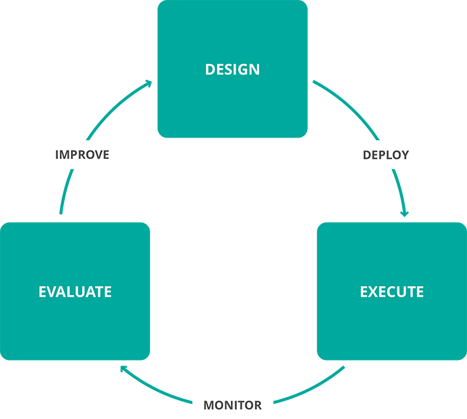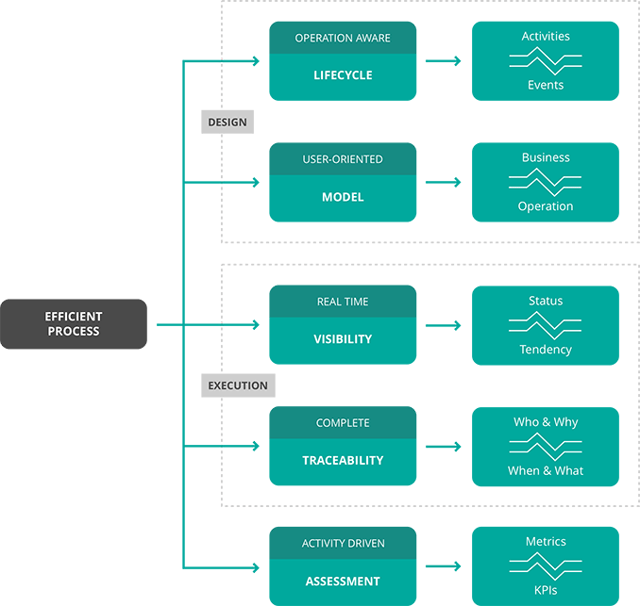A lot has been said about lean strategies and the virtues of making your processes more efficient. But the real question is: What do I need to do to make a lean dream come through and, more importantly, how do I make sure I don’t revert to the nightmare?
Lean is definitively the underlying fabric of any attempt at making your operations efficient and a lot has been written and discussed on that subject. There are multiple different strategies to analyze and design lean-oriented processes, all of them focused on reducing waste on any given process. The challenge however is to actually deliver that lean vision in the real world, combining business requirements with operational tasks, while assuring the underlying management systems are duly updated and all process stakeholders have confidence on the usability of the process and the quality of the end result.
It comes without surprise that the failure rates for lean implementations, and I’m not talking just at manufacturing level because lean thinking is applicable in any process oriented mission, are staggering. Check this report to see how difficult it really is. Obviously, lack of senior management engagement, failure to manage change, poor communication and misplaced priorities, among others, make it impossible for a lean strategy to achieve the expected results. But even if you have all of those in place, it still is a daunting task to bring a process lean vision to life. It is even harder to assure that your process will remain efficient and that, over the coming future, you will be able to continuously understand how your process is behaving, where it is deviating and what needs to be done to rebalance it.
So, what do you need to do to achieve lean nirvana? As with most complex problems, you need to divide to conquer, taking a systematic approach to every single critical process in your mission. And you guessed it, the process itself needs to be the single most important thing in your life, as all revolves around your ability to map, execute and assess it.
Sustainable process efficiency comes from adopting a continuous, iterative approach. The sad reality is that no matter how much you invest in understanding and designing a process, you still need the hard proof of real life to observe what works and what doesn’t. So, it’s best to iterate and improve continuously than to expect that, on one single magical sweep, you’ll get it right in your first attempt. So review it often, deploy it consistently and assess it continuously to achieve sustainability:

As much as this is a sustainable framework to engage in process improvement, you need to be aware of the complexity involved in each fundamental stage. And you need a consistent strategy to make sure your design is feasible, that your execution is consistent and that your evaluation process does generate valuable information to drive improvement.
So, here are the five things you need to focus on to truly exceed lean expectations in your processes:

Let’s break it down by each fundamental activity. In the design activity, you need to:
-
Define an operation-aware process lifecycle. This means that you need to understand the process from an operational standpoint, mapping all activities and how they relate to each other by identifying the events that make the process flow from one activity to another. This is your process map, or how you expect the process to be executed, how you expect it to flow and ultimately how you will control it.
-
Create a user-oriented model. For each of the identified activities, you must define how each user will perceive information about the process at hand, how he will execute it and how each task needs to be controlled in order to assure an error free activity. At this stage, you need to identify how each business rule and management system needs to be involved in each task, clarifying what results are expected and how these results need to be propagated across the organization.
As deliverables from these two design visions you must get:
-
A consistent process model that maps all activities and the events that make the process flow between them;
-
The user interfaces for each activity, clarifying checkpoints and validations;
-
The results expected for each successfully completed event, mapping them across all management systems involved, may them be internal or external.
This will allow you to deploy a consistent process execution, considering both operational as business restrictions and assuring compliance with your mission. In order to properly execute the process, you need to assure two very important things:
-
Real time visibility, through the use of activity-oriented process dashboards that represent the ongoing process and display real life information about each of them. This enables you to perceive how far along each instance is on the process and, more importantly, it gives you a bird’s eye, in your face, up to the second perception of how the activities are doing, i.e., the tendency. This means the ability to take preventive measures on a process that has been consistently mapped against the operations and tracked consistently as it is executed.
-
Complete traceability, by keeping exhaustive records about who did what, when, why and what results were obtained. This may seem a little too much but the truth is that reliability comes from examining evidences of failures in order to understand what went wrong and provide corrective measures that address root causes. And accountability is only achievable if there is consistent past data to assure a global, common understanding that processes are consistently monitored.
As it turns out, this means that you need to consider a few more deliverables from your design:
-
Consistent process dashboards, intimately tied into the process activities and that display real time information about process status and tendency. Focus on building simple, intuitive dashboards that give you information at a glance and, if required, allow you to drill down into the specifics of a particular process instance;
-
A process oriented, traceability dictionary to identify all information that must be maintained in each process activity, related to every task performed and event processed. This will allow you to map post mortem data mining activities that make root cause analysis and resolution a breeze.
Finally, to conduct a consistent evaluation of your process you need to:
-
Define an activity driven assessment, based on clear, objective metrics and KPIs that are collected from real time process execution dashboards and traceability information. This will allow you to identify bottlenecks, their source and potential solutions. This is critically valuable information to be used in a next stage design activity, where improvement of an existing, well formed, consistently mapped operation is reviewed.
These five key topics, if properly aligned, generate a solid foundation and a consistent landscape that delivers efficiency in spite of irregularities and odd behaviors.
Furthermore, it is the backdrop that allows you to project change easily and adapt far more easily to new challenges. It also promotes disruption, because it leads people at all levels in the organization to focus on the key, most important things that make your organization better and unique. And this is possible because the process is mapped using DNA engraved concepts, you have real time feedback from the operation and you are able to assess if you’re improving or not, continuously. This means people see results from their actions and are able to adapt to be better. Lean thinking.
At Processware we’ve been helping companies build operation-aware, user-oriented, real time execution landscapes with extreme traceability and continuous activity driven assessment for years. And we’ve achieved some remarkable results, that makes us believe that lean thinking is not only a possibility as it is the foundation for sustainable efficiency. You just need to get processes right and focus on these essentials to achieve it.